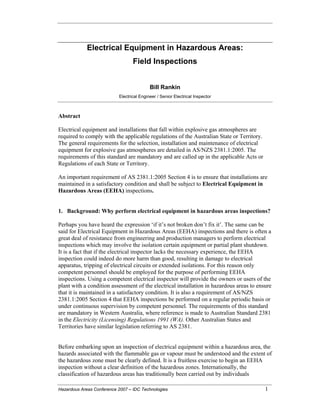The Buzz on Roar Solutions
The Buzz on Roar Solutions
Blog Article
The Basic Principles Of Roar Solutions
Table of ContentsRoar Solutions for DummiesAll About Roar SolutionsThe Best Strategy To Use For Roar Solutions
In order to secure installments from a possible explosion a technique of evaluating and classifying a potentially hazardous area is required. The objective of this is to make certain the appropriate choice and installation of equipment to inevitably avoid an explosion and to guarantee safety of life.
(https://roarsolutions.mystrikingly.com/blog/master-emergency-response-with-roar-training-solutions-and-eeha-courses)
No tools ought to be mounted where the surface area temperature of the equipment is more than the ignition temperature of the offered threat. Below are some common dirt harmful and their minimal ignition temperature. Coal Dust 380C 225C Polythene 420C (melts) Methyl Cellulose 420C 320C Starch 460C 435C Flour 490C 340C Sugar 490C 460C Grain Dirt 510C 300C Phenolic Resin 530C > 450C Aluminium 590C > 450C PVC 700C > 450C Soot 810C 570C The chance of the risk existing in a concentration high sufficient to trigger an ignition will differ from location to location.
In order to classify this danger an installation is separated into locations of danger depending upon the quantity of time the dangerous exists. These areas are described as Zones. For gases and vapours and dirts and fibres there are 3 areas. Area 0 Area 20 An unsafe atmosphere is very likely to be present and might exist for long durations of time (> 1000 hours each year) and even continuously Area 1 Zone 21 A dangerous atmosphere is feasible yet not likely to be existing for long periods of time (> 10 450 C [842 F] A category of T6 implies the minimal ignition temperature level is > 85 C [185 F] Hazardous area electrical devices maybe created for usage in higher ambient temperature levels. This would showed on the score plate e.g. EExe II C T3 Ta + 60C( This means at 60C ambient T3 will not be surpassed) T1 T1, T2, T3, T4, T5, T6 T2 T2, T3, T4, T5, T6 T3 T3, T4, T5, T6 T4 T4, T5, T6 T5 T5, T6 T6 T6 A T Course ranking of T1 implies the maximum surface temperature level created by the tool at 40 C is 450 C. Assuming the associated T Class and Temperature rating for the equipment are proper for the area, you can always use an instrument with a more stringent Division rating than required for the area. There isn't a clear response to this inquiry however. It really does rely on the sort of equipment and what repair services require to be carried out. Equipment with details examination treatments that can not be done in the area in order to achieve/maintain 3rd party rating. Have to return to the factory if it is prior to the devices's solution. Area Repair By Authorised Employee: Complicated screening may not be called for nonetheless certain procedures might require to be followed in order for the equipment to preserve its third party score. Authorized employees should be employed to do the job correctly Fixing have to be a like for like replacement. New part should be considered as a direct substitute needing no unique testing of the tools after the repair is full. Each item of devices with a hazardous ranking need to be examined separately. These are detailed at a high level listed below, however, for even more thorough info, please refer directly to Go Here the guidelines.
The 7-Minute Rule for Roar Solutions
The tools register is a detailed database of tools documents that includes a minimum set of areas to recognize each item's area, technical specifications, Ex lover category, age, and ecological data. The ratio of Detailed to Close evaluations will certainly be figured out by the Tools Danger, which is evaluated based on ignition danger (the chance of a source of ignition versus the chance of a flammable ambience )and the hazardous area category
( Zone 0Area 1, or 2). Applying a robust Risk-Based Evaluation( RBI )technique is essential for making certain compliance and safety and security in taking care of Electric Equipment in Hazardous Areas( EEHA).
The 2-Minute Rule for Roar Solutions

In regards to eruptive threat, a hazardous area is a setting in which an explosive ambience exists (or may be anticipated to be existing) in amounts that require unique safety measures for the building, installation and use devices. Roar Training Solutions. In this article we explore the difficulties encountered in the workplace, the risk control actions, and the needed competencies to work securely
These materials can, in certain problems, form explosive environments and these can have significant and terrible repercussions. Most of us are familiar with the fire triangle eliminate any one of the three aspects and the fire can not occur, yet what does this mean in the context of unsafe locations?
In most instances, we can do little about the levels of oxygen in the air, but we can have substantial influence on sources of ignition, for instance electrical tools. Unsafe locations are documented on the hazardous location classification illustration and are recognized on-site by the triangular "EX-SPOUSE" sign. Here, amongst various other crucial details, zones are divided into 3 kinds relying on the threat, the chance and duration that an eruptive environment will certainly exist; Area 0 or 20 is deemed the most dangerous and Area 2 or 22 is regarded the least.
Report this page